Papers by Deepak Phalgune
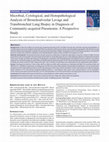
The Indian Journal of Chest Diseases and Allied Sciences
Background: In India, the incidence of community-acquired pneumonia (CAP) is 4 million cases per ... more Background: In India, the incidence of community-acquired pneumonia (CAP) is 4 million cases per year, with 20% requiring hospitalization. A causative agent may not be isolated in about half of the cases despite careful testing. There is a paucity of data regarding the role of bronchoscopy with bronchoalveolar lavage (BAL) coupled with transbronchial lung biopsy (TBLB) in the diagnosis of CAP in the Indian population. This research aimed to evaluate the microbial, cytological, and histopathological analysis of BAL and TBLB in the diagnosis of CAP. Materials and methods: This prospective observational study was conducted on 54 patients aged above or equal to 18 years of either sex who presented as CAP and were either immunocompromised, had non-responding pneumonia, or had radiology suggestive of atypical involvement of the lung. The BAL and TBLB with relevant microbiological, cytological, and histopathological investigations were carried out. The primary objective was to find the diagnostic yield of BAL and TBLB in patients presenting with CAP. The statistical agreement between the two diagnostic methods was tested using the Cohen-kappa technique. The sensitivity and specificity were calculated using the appropriate gold standard. Results: The diagnostic yield was 75.9% on BAL, 94.4% on TBLB, and 100% with combined use of both BAL and TBLB. The sensitivity of BAL and TBLB was 91.1 and 88.9%, respectively, in the diagnosis of CAP. Forty-three (79.6%) patients showed infective pathogens, such as Pseudomonas aeruginosa (18.5%), Klebsiella pneumoniae (16.6%), Mycobacterium tuberculosis (18.5%); 9 patients (16.6%) were having non-infective etiology; while 2 patients (3.7%) were having combined etiology (infective + non-infective). Rare causes such as Mucormycosis 2 (3.7%), Nocardia 3 (5.6%), Pneumocystis jiroveci pneumonia (PJP) 2 (3.7%), and Aspergillosis 4 (7.4) which presented as necrotizing pneumonia were also identified. Conclusion: Bronchoalveolar lavage and TBLB have a good diagnostic yield in patients presenting as CAP.
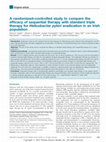
Indian Journal of Clinical Anaesthesia, Feb 15, 2022
Introduction Eradication rates for the standard first-line triple therapy for Helicobacter pylori... more Introduction Eradication rates for the standard first-line triple therapy for Helicobacter pylori infection have decreased in recent years. Sequential therapy has been suggested as an alternative. The efficacy of sequential therapy has not been assessed to date in an Irish population. Objective The aim of this study was to compare the efficacy of standard triple therapy with sequential therapy for H. pylori eradication. Patients and methods A prospective randomized-controlled study was carried out. Treatment-naive H. pylori-infected patients were randomized to receive either standard triple therapy or sequential therapy. Results In all, 87 eligible patients were recruited into the study, one of whom dropped out. Fifty-one per cent (N = 44) patients received standard triple therapy and 49% (N = 42) patients received sequential therapy. The eradication efficacy by intention-totreat analysis was 56.8% [N = 25/44; 95% confidence interval (CI) 42.2-71.4%] for standard triple therapy and 69% (N = 29/42; 95% CI 55.0-83.0%) for sequential therapy. The eradication rates by per-protocol analysis for standard triple therapy and sequential therapy were 61% (N = 25/41; 95% CI 46.1-76.0%) and 69% (N = 29/42; 95% CI 55.0-83.0%), respectively. The differences in eradication rates for each treatment by either intention-to-treat or per-protocol analysis were not statistically significant (P = 0.24 and 0.44, respectively). In addition, incidence in adverse events was not significantly different between the study groups. The most common adverse event reported was mild nausea at 15% (95% CI 7.5-22.6%). Conclusion Sequential therapy had a nonstatistically significant advantage over standard triple therapy in our patient cohort. However, eradication rates for both standard triple therapy and sequential therapy were suboptimal. Further studies are required to identify potential alternatives to standard first-line triple therapy.
International journal of medical ophthalmology, Jul 1, 2021
Introduction: The most common abnormalities seen in pregnancy induced hypertension (PIH) are fund... more Introduction: The most common abnormalities seen in pregnancy induced hypertension (PIH) are fundus spasm, focal/generalized narrowing of retinal arterioles, haemorrhages, exudates, peripapillary or focal retinal oedema, serous retinal detachment, bilateral retinal detachment, exudative retinal detachment and severe macular oedema. There is a paucity of data available in the published literature on the prevalence of retinal changes in PIH from India. Aim: The purpose of the present study was to find the prevalence of retinal changes in PIH and the association between the retinal changes and severity of PIH. Materials and Methods: 350 women with gestational ages between 20 and 40 weeks admitted in the maternity ward in the

Saudi Surgical Journal, 2020
Background: The aim of the present study was to find the utility of upper gastrointestinal (UGI) ... more Background: The aim of the present study was to find the utility of upper gastrointestinal (UGI) endoscopy in predicting the persistence of postoperative pain following laparoscopic cholecystectomy (LC) and to find the prevalence of other UGI pathologies before LC. Materials and Methods: Ninety patients ≥18 years of age who have gallbladder stones confirmed by ultrasonography were included in this prospective observational study. All patients were subjected to UGI endoscopy (UGIE) examination 1 day before operation. Postoperative follow-up was done on day 1, 14, and 30 for the symptoms. The primary outcome measure was the persistence of postoperative pain, whereas the secondary outcome measure was the prevalence of UGI pathology. The comparison of quantitative variables and qualitative variables was done using the unpaired Student's t-test and the Chi-square test/Fisher's exact test, respectively. Results: The majority of the patients (63.3%) had atypical symptoms. The incidence of the severity of postoperative pain at day 1, day 14, and day 30 did not differ significantly between typical symptoms group and atypical symptoms group. The postoperative pain at day 14 and day 30 was 62.9% versus 20.0% and 45.7% versus 5.5% in an abnormal UGIE group and normal UGIE group, respectively (P = 0.001 for both). In all 20 (22.2%), 9 (10.0%), 1 (1.1%), 2 (2.2%), and 3 (3.3%) had gastritis, deudenitis, gastric ulcer, deudenal ulcer, and gastrooesophageal reflux disease (GERD), respectively. Conclusions: Patients should undergo UGIE before LC to find the presence other UGI pathology.
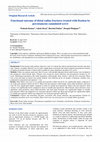
International Journal of Research in Orthopaedics, Aug 26, 2019
Background: In the present study primary objectives were to evaluate the clinical and functional ... more Background: In the present study primary objectives were to evaluate the clinical and functional outcome and union rates, whereas secondary objective was to study complications associated with closed reduction percutaneous fixation of displaced unstable fractures of distal radius in adults by using cannulated cancellous (CC) screw. Methods: Thirty two patients aged more than 18 years, with unstable displaced distal radial fracture were included in this prospective observational study. Patients were treated by closed reduction and percutaneous fixation by CC screw. Radiological parameters like radial inclination, radial height, ulnar variance, volar tilt were measured. Mayo wrist score and range of motion were noted. Patients were followed up for six months. Continuous variables were compared by using paired and unpaired 't' test. Results: Mean Mayo wrist score at six months post-operative follow-up (82.8) was significantly higher compared to six weeks post-operative follow-up (64.4). Mean early post-operative radial height, mean radial inclination, and mean volar tilt were significantly higher compared to mean six months post-operatively. Mean early post-operative ulnar variance was significantly lower compared to mean six months post-operatively. Mean flexion, mean extension, mean supination, mean pronation, mean radial deviation, and mean ulnar deviation was significantly higher six months post-operative follow-up compared to six week post-operative follow-up. Mean grip strength was significantly higher six months post-operative follow-up compared to six week post-operative follow-up. Conclusions: Clinical and functional outcomes associated with closed reduction and percutaneous fixation by cannulated cancellous screw was excellent. Mayo wrist score was increased over six months follow up period.

Indian Journal of Dental Research, 2019
Background and Objective: There have been numerous studies of oral health status of school childr... more Background and Objective: There have been numerous studies of oral health status of school children and young population; however, similar studies in elderly population in India are lacking. With advances in medical science and consequent increase in life expectancy, elderly population is on the rise and is a subject of growing concern for public health policy. Hence, an attempt was made to study factors influencing decayed, missing, and filled teeth (DMFT) index, oral health awareness, and dental treatment-seeking behavior of elderly population. Methods: A cross-sectional community-based survey was conducted between September 2014 and December 2014 in villages in rural Maharashtra. Sociodemographic and health-related information were collected from 352 participants 60 years of age and above in 10 villages. Results: Prevalence of dental caries was 76.4% in a study population with median DMFT score of 12 with interquartile range of 7–22. The majority of the participants cleaned their teeth with fingers using charcoal and mishri. Only 17.2% participants used toothbrush. About 39% participants had experienced dental pain, of which majority did not visit dentist. The median DMFT index who used toothbrush and toothpaste was significantly less when compared with participants who did not use tooth brush and tooth paste. The majority of the participants had one or more missing teeth, but only 2.2% were using dentures. Conclusion: There is an urgent need for comprehensive oral health educational programs, and accessible and affordable oral health services to be provided to rural community.
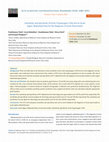
Acta Scientific Gastrointestinal Disorders, 2022
Background: There are little data in the literature on the sensitivity of the urine trypsinogen 2... more Background: There are little data in the literature on the sensitivity of the urine trypsinogen 2 (UT-2) test in the diagnosis of acute pancreatitis, and results have been controversial. Also, studies of UT-2 test in the Indian population are few in number. The aim of the present study was to find the sensitivity and specificity of UT-2 dipstick test for the diagnosis of acute pancreatitis in acute upper abdominal pain patients. Material and Methods: One hundred-sixty-six patients aged between 18 and 80 years presenting with acute abdominal pain were included for this cross-sectional observational study. All the patients were tested with UT-2 dipstick test, serum amylase, serum lipase. Ultrasonography or contrast-enhanced computed tomography of abdomen was performed simultaneously. The diagnostic efficacy index such as sensitivity, specificity, positive predictive value, negative predictive value was calculated using the appropriate gold standard. Results: The sensitivity and specificity of UT-2 dipstick test for detecting acute pancreatitis were 90.7% and 87.5% respectively. The sensitivity and specificity of serum amylase for detecting acute pancreatitis were 61.1% and 100.0% respectively. The sensitivity and specificity of serum lipase for detecting acute pancreatitis were 81.5% and 100.0% respectively. Conclusions: The UT-2 test had good sensitivity and specificity and can be used reliably for the diagnosis of acute pancreatitis in acute upper abdominal pain.
Asian journal of pharmaceutical and health sciences, Sep 7, 2021
Asian journal of pharmaceutical and health sciences, 2020
Asian journal of pharmaceutical and health sciences, 2019
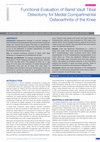
Journal of Clinical and Diagnostic Research, 2017
The present prospective study was conducted in Poona Hospital and Research Centre, between May 20... more The present prospective study was conducted in Poona Hospital and Research Centre, between May 2012 and May 2015. Fifty five patients in the age group 45 to 60 years with suspicion of medial compartmental osteoarthritis knee were included in the study. Based on previously published study [5], setting an alpha error at 0.05, and power at 80%, sample size of 50 patients was calculated by formula [9] for this prospective study. Patients with Medial compartmental osteoarthritis associated with patellofemoral osteoarthritis and also who had range of motion ≥ 90 degrees were included in the study. Exclusion criteria involved Tri compartmental OA knee, medial and lateral compartment OA, patient with restricted range of motion/ fixed deformities (knee flexion < 90 degrees, > 20 degrees of valgus correction needed, flexion contracture of > 15 degrees), patients with ligamentous instability, Lateral tibial subluxation of more than 1 cm, medial compartment tibial bone loss of more than 2 or 3 mm.
Asian journal of pharmaceutical and health sciences, 2020
Asian journal of pharmaceutical and health sciences, 2018
Asian journal of pharmaceutical and health sciences, 2018
Asian journal of pharmaceutical and health sciences, 2019
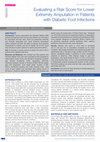
Journal of Clinical and Diagnostic Research, 2018
Introduction: Factors associated with Diabetes Mellitus (DM) patients developing a foot ulcer are... more Introduction: Factors associated with Diabetes Mellitus (DM) patients developing a foot ulcer are well defined, but risk factors for amputation are less clear. There are substantial morbidity and mortality associated with Lower Extremity Amputation (LEA) in patients with DM. The ability to identify which patients hospitalised for diabetic foot are at highest risk of LEA, could help clinicians to direct patients for special preventive efforts. Aim: To develop a scoring system to predict the risk of LEA in patients with a diabetic foot ulcer. Materials and Methods: One hundred and fifty patients with infected diabetic foot ulcer were included for this prospective, observational study. Score was allotted to following variables: age, sensory neuropathy, motor neuropathy, deformity, Infectious Diseases Society of America (IDSA) infection grade, past H/O amputation, ulcer depth grade, duration of DM, HbA1c, Rutherford grading and ankle brachial index. Total score of each subject was calculated after adding scores of risk factors. Statistical significance of categorical variables was tested using chi-square test or Fisher's-Exact test. Threshold cutoff of total risk score for predicting incidence of amputation was determined using Receiver Operating Characteristics (ROC) curve analysis. Measures of diagnostic efficacy indices such as sensitivity, specificity, positive predictive value, negative predictive value and accuracy were calculated. Results: Patients with score of >16.5 were at increased risk of LEA and risk of amputation increased as the score increased. Percentage of patients who required amputation was significantly high in >65 years of age, duration of DM >20 years, sensory neuropathy Grade 2, presence of motor neuropathy, presence of deformity, IDSA infection Grade IV, past H/O amputation, ulcer depth Grade IV, HbA1c ≥12.5% (113.5 mmol/ mol), ankle brachial index ≤0.9 or ≥1.30, and Rutherford Grading IV. Multivariate analysis revealed that duration of DM, HbA1c, Rutherford grading and ankle brachial index were significantly associated with LEA. Conclusion: The score will help clinicians to identify patients at high risk of LEA on examination.
Indian Journal of Surgery, Apr 14, 2023
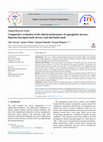
Indian Journal of Clinical Anaesthesia, Mar 15, 2023
There are no studies comparing Supreme laryngeal mask airway (LMA), I gel and Baska mask in India... more There are no studies comparing Supreme laryngeal mask airway (LMA), I gel and Baska mask in Indian population. A comparison of the clinical performance of Supreme LMA, I gel and Baska mask was undertaken in this randomized controlled study. Materials and Methods: The present research was undertaken in 75 patients aged 18 to 60 years who underwent elective surgery for less than 3-hour duration under general anaesthesia. The patients were randomly divided into three groups; Supreme LMA, I gel, and Baska mask. The oropharyngeal leak pressure (OLP) after 30 minutes to loss of spontaneous respiration was the primary objective, whereas the secondary objectives were attempts required for insertion of LMA, ease of gastric tube insertion, time required for gastric tube insertion and post-operative morbidity. Results: The mean OLP of Baska mask group was (28.2 cm H 2 O) as compared to Supreme LMA (25.3 cm H 2 O) and I-gel (24.1 cm H 2 O) groups (p-value = 0.0001). The mean gastric tube insertion time of Baska mask group was (20.7 s) as compared to Supreme LMA (6.7 s) and I-gel (9.6 s) groups (p-value = 0.0001). The three groups were comparable with regards to the number of attempts required, ease of gastric tube insertion and post-operative morbidity. Conclusion: A higher OLP was observed in Baska mass group as compared to Supreme LMA and I-gel. The three devices were similar in terms of attempts required for insertion, ease of gastric tube insertion and post-operative morbidity. This is an Open Access (OA) journal, and articles are distributed under the terms of the Creative Commons Attribution-NonCommercial-ShareAlike 4.0 License, which allows others to remix, tweak, and build upon the work non-commercially, as long as appropriate credit is given and the new creations are licensed under the identical terms.

International Surgery Journal, Dec 30, 2022
Background: The existence of numerous techniques for creation of pneumoperitoneum at laparoscopy ... more Background: The existence of numerous techniques for creation of pneumoperitoneum at laparoscopy indicates that none has been proven totally efficacious or complication free. There is dearth of study in India comparing these techniques. The aim of present study was to compare the safety and duration for creating pneumoperitoneum between direct trocar (DT) and Veress needle (VN) technique. Methods: One hundred-fourteen patients aged between 18 and 70 years were included in this single-blind randomized controlled study. Group DT and group VN patients underwent laparoscopic surgery after trocar placement by direct trocar insertion technique and Veress needle technique respectively. The primary outcome measure was the incidence of complications whereas secondary outcome measures were number of items required and time needed to introduce the laparoscope. Intergroup comparison of categorical and continuous variables was done using the Chi-square test/Fisher's exact test and unpaired t-test respectively. Results: The number of attempts for trocar placement, and complications were comparable between direct trocar and Veress needle group. The mean duration of trocar placement at the first attempt was 102.6 and 142.3 seconds in direct trocar and Veress needle group respectively (p value =0.001). Conclusions: Veress needle is a safe, efficient, and rapid alternative technique as compared to direct trocar.
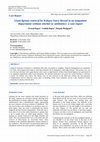
International Surgery Journal, Dec 30, 2022
Considering the structure of the non-malignant lipoma, it was decided to tie the Kshar Sutra at t... more Considering the structure of the non-malignant lipoma, it was decided to tie the Kshar Sutra at the base of the lipoma. Kshara Sutra (medicated thread) ligation was done as an outpatient procedure. In the left lateral position, local anaesthesia was given at the base of the lipoma. Then a notch was made in the skin to assure fix ABSTRACT Surgical treatment of lipomas is considered when they are painful or unsightly. Surgical management can sometimes be tricky, and surgeons must keep in mind the potential risk of malignancy with large tumours. The present case was of a 46-year-old male with a giant lipoma with a neck on right buttock. Kshara Sutra thread ligation was performed in an outpatient department under local anaesthesia. No internal medication was given for wound healing or infection control. No stitches were taken. The lipoma was cut and removed on the third day without any post-operative complications such as infection, severe pain, or bleeding. Kshar Sutra treatment can be a safe, alternative herbal treatment for lipoma with the neck.
Uploads
Papers by Deepak Phalgune